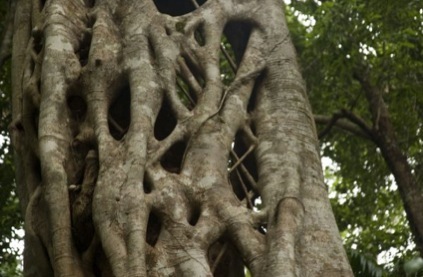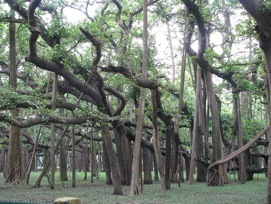Wild Ficus: Who Gives An Edible Fig?
It’s only 90 miles to the east, and 117 to the west, but the Strangler Fig and Banyan trees will grow farther south and on each coast but not here in Central Florida. One is a native, and one came from India, but they’re cousins none the less, figs as it were, and in the greater Mulberry family. You didn’t know figs and mulberries were related? You do now.
The trees take over in similar ways. The Strangler Fig often starts as an epiphyte, a seed “deposited” by a bird in the top of a tree. The fig sends a root down to find earth. Once it does It slowly takes over the tree, enveloping it, sending down more roots. In time it becomes a huge tree. Usually the original victim simply dies and disappears.
The Banyan “walks.” The first time you see one you are amazed. The horizontal branches send down vertical “prop” roots that grow into trunks. The tree simply keeps growing out and down, covering acres. Nearly everything under its shade dies.
The Florida fig is Ficus aurea, FYI-kuss AR-ree-ah, or FEEK-uss AW-ree-ah, Ficus is an old Latin name for the tree or fruit and probably comes from the older Greek word for fig, Siga (SEE-gah and earlier sykon.) Aurea means golden, referring to the figs’ color when ripe. The Miccosukee and Creeks indians called the tree a phrase that gets translated into the “sticks to you” perhaps a reference to the latex sap. They ate the ripe fruit, used the stems for arrows, made bowstring and netting out of the bark of the roots. They used latex to treat wounds. That latex can also be used to curdle milk for cheese making. The Indians also used the dried latex like gum.
The Banyan tree is also a fig, now called Ficus benghalensis (ben-gal-EN-sis) meaning from Bengal. The largest is in India and covers four acres. It has a circumference of about a half a mile, is some 80 feet high and has (as of 2008) 2880 aerial roots reaching down to the ground. It is said it can shelter 2,000 people.
The reddish fruit of the Banyan tree is not toxic per se but they are barely edible, the worst of famine food. While its leaves are said to be edible, they are more often used as plates and for wrapping food. Fig leaves are also used to impart flavor to fire cooked foods. Some fig leaves in some areas are cooked and eaten. There is only one original reference to the leaves of the F. benghalensis as being edible so I would view it as suspect. I would want more independent confirmation before I tried to eat one. But, I would cook with it and wrap with it. The Banyans grow in the warmer areas of the United States including Florida, Texas, Arizona and Southern California.
A third fig in Florida is the Shortleaf Fig or Ficus citrifloia. As its name implies it has leaves similar to citrus trees. The one-inch fruit goes from yellow to dark red when ripe. It is edible but not prime — tasteless actually — and is not improved by cooking.
On a personal note, I have a fig tree in my front yard that is at least 80 years old, and probably much more, from the Azores. Of course, the fig would not be allowed in the United States now but it got here when folks weren’t concerned about such things. The grandfather of a friend married a Portuguese woman back in the 1930s. She was from the Boston area but her family was directly from the Azores, Portuguese being their first language as in my family Greek was. Either she or her relatives brought a cutting from a fig tree in the Azores to Florida via Boston and planted it next to their house in DeLand, Florida. Some 70 years later the original slip, now an aging tree, was losing a battle with dry rot so I took several slips off the tree and got them to root. The tree is gone now but at least four of those slips are still growing and are now trees themselves. They grow big green figs similar to the Kalamata figs of my ancestral home, the Mani, in Greece. That tree, or it clones, has been in the presence of a lot of human life. How old was it on the Azores before a slip was taken? We’ll never know. That slip endured several thousand miles at sea and then a slow 1,200 mile drive down the east coast of the United States. It grew next to the house where Vern Gifford raised two kids, saw numerous grandchildren and went quickly while in his 90s. And the tree lives on.
Also edible: Ficus auriculata, fruits; Ficus benjamina, ripe fruit; Ficus carica, ripe fruit; Ficus capensis, fruit, young aerial shoots eaten as a vegetable, bark is chewed with cola nuts to alleviate thirst; Ficus elastica, fruit and young leaf shoots cooked. This is the infamous “rubber plant” in home and offices around the world; Ficus glomerata, young shoots cooked, Ficus hirta, very young top shoot eaten raw, ripe fruit edible; Ficus insipida, fruit sometimes good to eat; Ficus lacor, young shoots and sour leaves eaten raw or cooked. Fruit also edible; Ficus laevigata, ripe fruit; Ficus palmata, fruit edible, unripe figs and leafy young shoots boiled and fried and used as a green vegetable; Ficus pseudoplama, young leaves are eaten raw in salads or cooked as a potherb. Fruits also edible; Ficus pumila, ripe fruit; Ficus racemosa, ripe fruit edible, unripe fruits pickled, young shoots eaten raw or cooked; and, Ficus sycomorus, fruit edible, leaves eaten in soups.
Two factoids: Figs are pollinated by a wasp that crawls into the developing fruit. Its “blossoms” all face inward. And the fig tree, called “sycamore” in the Bible, was a common wood for caskets back then. It is the most common ancient casket wood found today.
Green Deane’s “Itemized” Plant Profile
IDENTIFICATION: Strangler fig: Tree to 65 feet, milky sap, orange twigs, smooth gray or light brown bark, flaking, many aeriel roots. Leaves alternate, stalked, oblong, oval or elliptic, pointed or wedge shaped, two to five inches long, leathery, dark glossy above, paler below. Fruit stalkless, yellow when unripe, dark red when ripe, about one half inch wide.
TIME OF YEAR: All year
ENVIRONMENT: Hammocks, pine lands, old residential areas
METHOD OF PREPARATION: Raw fruit out of hand. Latex as chewing gum. Banyan leaves can be used as plates and to wrap food.



